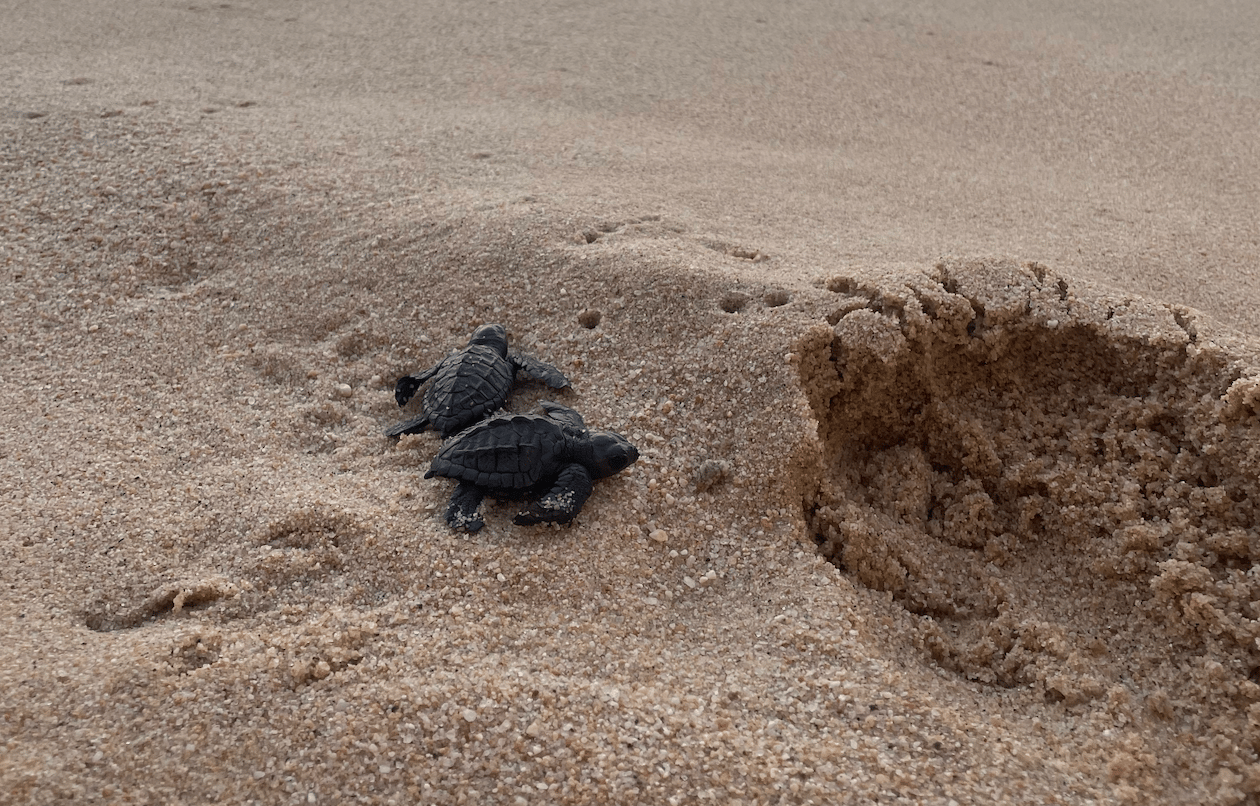Why I Ignored My Daughter in Cabo
When Nash Equilibrium Prevails Over Good Manners
A few weeks ago, we went to Cabo. Yes, you should be jealous.
My wife and I, along with our two adult children, spent several relaxing days at a beachfront resort. Our agenda was simple: sleep, watch movies, play games, swim, walk on the sand, and squeeze in some Christmas shopping.
Mid-week, while lounging by the pool, a staff member made her rounds announcing: "Las tortugas estarán en la playa a las 5 de la tarde." My Spanish may be rusty, but I caught the key words: "turtles," "beach," and "5 PM." That was it—no other information, just the vague promise of turtles.
Following my father's ironclad rule ("early is on time, on time is late, and late is unacceptable"—what can I say, Dad was a hardass), we headed to the beach at 4:45 PM. A few people were already gathered where staff had marked off about 20 yards of sand. We staked our claim near the edges and waited. As the hour approached, more and more people gathered, drawn by the mysterious tortugas possibility.
Around 5:20 (Dad would have been appalled), staff members began raking the marked area, working their way toward us. My daughter, ever considerate, insisted we move back. She figured they'd make us retreat anyway, so why not give them space? I told her my gut said to stay (but my gut was thinking of Nash equilibrium—don't worry, I'll get to it).
Sure enough, some people did retreat preemptively, but their spots were instantly claimed by others. Every time someone moved back, someone else swooped in. We held steadfast to our 4:45 PM position.
The rakers worked right up to us, then headed back up the beach where they met an ATV pulling a trailer. Turns out, the raked area was a makeshift launching pad for over 200 baby sea turtles. For the next half hour, we witnessed the cutest, slowest race to the ocean of all time. Tiny hatchlings lined up and began their determined crawl to the Sea of Cortez. And we had front-row seats—all thanks to good timing and a decent understanding of Nash equilibrium.
So this week, let's talk about Nash equilibrium. What it is, why it matters, and how being aware of it can help you in the end.
What is Nash equilibrium?
Nash equilibrium was developed by mathematician John Nash in 1950 while he was a graduate student at Princeton. The concept earned him a Nobel Prize in Economics and later inspired the movie "A Beautiful Mind." Nash's breakthrough was showing that in any competitive situation involving two or more participants, there exists at least one state where everyone is making their best possible move, given what everyone else is doing.
To put it more simply: it's a state where everyone is making the best possible choice they can, given what everyone else is doing. Even if there might be a better outcome for the group as a whole, no single person can improve their situation by changing only their own behavior.
Our turtle-viewing scenario on that Cabo beach perfectly illustrates this concept. Although everyone might have had a better view if we all stepped back together, no individual person could improve their situation by moving back alone. Their spot would have instantly been claimed by someone else, leaving them with a worse view than if they had just stayed put. Think back to those beachgoers who retreated early, only to watch their spots get immediately claimed by others. Their individual good intentions couldn't overcome the equilibrium at play.
My daughter's suggestion to move back was considerate - and in a perfect world where everyone would do the same, it might have been the right call. But just as those baby turtles couldn't individually decide to take an easier path to the ocean, we were all locked into our positions by the collective dynamics at work. Each person was making their best possible choice given what everyone else was doing - a classic Nash equilibrium.
Why It Matters
Understanding Nash equilibrium matters because it explains why groups of rational people often end up in situations that seem, well, irrational. Back on that Cabo beach, everyone pursuing their own best interest led to an overcrowded viewing area—a perfect example of how individual rational choices might create collectively frustrating outcomes.
This same dynamic plays out in situations we encounter every day. Consider a concert where everyone stands up to see better. Of course, this means everyone is now just as blocked as before, but no one can sit down without completely losing their view. Everyone is now arguably less comfortable, yet stuck standing—not because it creates a better experience, but because no one person can improve their situation by being the only one to sit.
We see this pattern repeat across many areas:
In the workplace, employees stay late at the office not because they're more productive, but because leaving "early" might damage their career prospects if they're the only one doing it.
In environmental conservation, people may choose not to make sustainable choices because they feel their solo efforts won't make a difference if others don't join in.
At baggage claim, everyone crowds around the carousel even though we'd all see better if we stood back. But no individual can improve their position by being the only one to step back—someone else would just take their spot at the front. It’s the turtles all over again!
The power of Nash equilibrium lies in helping us understand why these situations persist, even when everyone involved can see they're suboptimal. Just as those early-retreating beachgoers quickly saw their spots claimed by others, we often find ourselves locked into patterns where breaking ranks individually leads to worse outcomes, even though collective change would benefit everyone
Nash equilibrium isn’t just about games; it’s about life. Every choice you make is shaped by the choices of those around you.
Sylvia Nasar
How Being Aware Helps You
Once you understand Nash equilibrium, you start seeing it everywhere. More importantly, you can use this knowledge to make better decisions. Me telling my daughter to stay put at the turtle release wasn't just stubbornness—it was game theory in action. Here are three ways this awareness can help you:
It prevents frustration. When you recognize a Nash equilibrium, you stop wasting energy fighting it or feeling guilty about your participation. At baggage claim, understanding why everyone crowds the carousel won't make your bag come faster, but it helps you accept the situation and plan accordingly—maybe by grabbing a coffee first and returning once the initial rush has died down.
It helps you spot opportunities for collective action. Sometimes, breaking free of a Nash equilibrium just requires coordination. In traffic, some cities are better than others at reducing congestion by coordinating traffic signals or encouraging carpooling. These systems rely on cooperation to ensure smoother commutes for everyone, demonstrating how collective action can break free from inefficient individual behaviors.
It helps you identify situations where you can gain an advantage by thinking differently. At a concert where everyone stands? Choose seats in the balcony instead of the floor. Stuck in an endless cycle of competitive holiday shopping? Shop online or during off-peak hours. Understanding Nash equilibrium helps you spot these opportunities to step outside the game entirely—just like arriving 15 minutes early to the turtle release gave us front-row seats to nature's slowest parade.
In Conclusion
Back on that Cabo beach, those baby turtles weren't thinking about game theory as they made their way to the sea. They were just following their instincts, each one doing what it needed to do to survive. But for our quasi sunburned family of four, understanding Nash equilibrium helped secure the best possible view of their journey.
Life is full of these moments—situations where individual choices create collective patterns that can seem frustrating or irrational. But understanding why these patterns emerge actually gives us power: the power to accept what we can't change, to coordinate when we can, and to find creative solutions when neither acceptance nor coordination gets the job done.
As for those turtles? They all made it to the ocean eventually, following their own paths but moving toward the same goal. Sometimes the best strategy isn't about changing the game—it's about knowing which game you're playing and being smart about how you play it. Just ask the 200 tiny turtles who made it to the sea that day, or the slightly sunburned family who had the perfect view of their journey.
Ever forward.
— Derek (aka Chief Rabbit)
Enjoying Chief Rabbit?
This newsletter is free and always will be. But if you’d like to support this work, you can. You’ll get monthly Q&As, vote on topics, stickers, and help keep this ad-free.
You can also follow me on Threads where I sound off on all sorts of nonsense OR LinkedIn where I tend to be a touch more serious.
Also, thanks for being someone who reads to the bottom of the page, you’re a special human.




